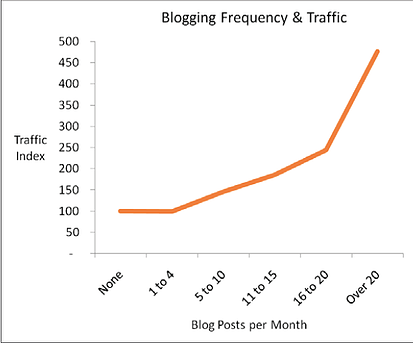Most of us know that blogging is good for business and we should be doing it, but why exactly?!
![]()
Blogging is an essential component of any inbound marketing plan. Businesses who blogged just 16 to 20 times per month got 3 times more leads than those who didn’t blog.
Producing blog content is now one of the best ways to increase your website’s search engine optimization.
Furthermore, blogs can help reinforce your brand, offer insights about your business processes and help establish your position as a trustworthy, authoritative leader in your industry.
Blogging helps to build trusting relationships for website visitors, which is the cornerstone of inbound marketing.
Learn more about just how important blogging is in our Lead Generation eBook.
Most companies understand the importance of blogging but fail to capitalize on its potential.
If you incorporate these best practices into your blogging, you should experience a steady growth in visitors:
- Blog regularly—One of the most important features of blogging is that it provides fresh content to improve your website’s rankings on the search engines. Google favors new content over static websites, so consistently providing text, pictures and videos on your e-commerce site through your blog is one of the most important best practices you can employ. Blogs that consistently add content on a weekly basis perform well in terms of SEO, but blogging more often doesn’t hurt. Businesses who blogged 16 to 20 times per month got over 2 times more traffic than those who blogged less than 4 times per month. Those who blogged at least 20 times per month had 5 times more traffic than those who blogged less than 4 times per month.

- Create interesting content—This blogging best practice is the stumbling block for most companies. You probably understand a blog is critical to your inbound marketing plan, however you might be unsure of how to engage visitors. Most successful blogs provide information, entertainment or industry insights that resonate with visitors and draw them back. Creating content that is somewhat controversial is also a best practice. Whatever content you produce, keeping it fairly light and interesting/entertaining to read is essential.
- Integrate links—Blogs serve as excellent anchors for links to other reputable sites. Stuffing links into your blogs is not an effective strategy, but introducing a few links per blog post will help your website move up Google’s search rankings.
- Invite submissions—Many successful blogs invite employees or members of partner organizations to submit a post. Not only does this add to the variety of the writing topics and styles, but it widens your audience. Your guest writer often brings his followers along to your site, and you have the opportunity to acquire new fans.
- Put your personality on display—Cultivating a relationship with the visitor is usually based on finding commonality. This identification with the blogger is facilitated by displays of humanity, humor, or genuine enthusiasm. It’s important to remember that blog writing is not like writing a news article. It can have some “flavor,” if you will.
- Make your blog visually appealing—Like all web content, attractiveness is extremely important. Use intriguing titles, format with bullets and good spacing and insert bold phrasing to allow readers to quickly understand the article’s main points. It is also important to include pictures and videos to draw the eye in and arouse interest that relates to your content.
- Respond to comments quickly—Developing a dialogue with visitors can generate considerable buzz. Responding to comments communicates to visitors that you are interested in their thoughts and suggestions. Having engaged visitors is helpful to any blog post, so treat them with respect and consideration.
- Include social media widgets—If you have done your job properly, visitors will want to share your blog with others. Including Facebook, Twitter or LinkedIn widgets will make it easier for visitors to share your blog with others after having read its wonderfully informative content.
Utilizing these blogging best practices may seem challenging at first, but as you integrate them into your weekly routine they should become second nature.
Most importantly, make blogging a priority because it may be the first thing a new visitor sees. Consider new blog topics throughout the week and bounce them off of co-workers. Be patient and committed, and eventually your efforts will attract the customers that your company desires.
Try this: Create a list of interesting blog topics targeting your specific buyer personas and then create a blog editorial calendar proposing 2 to 3 blog topics a week.





